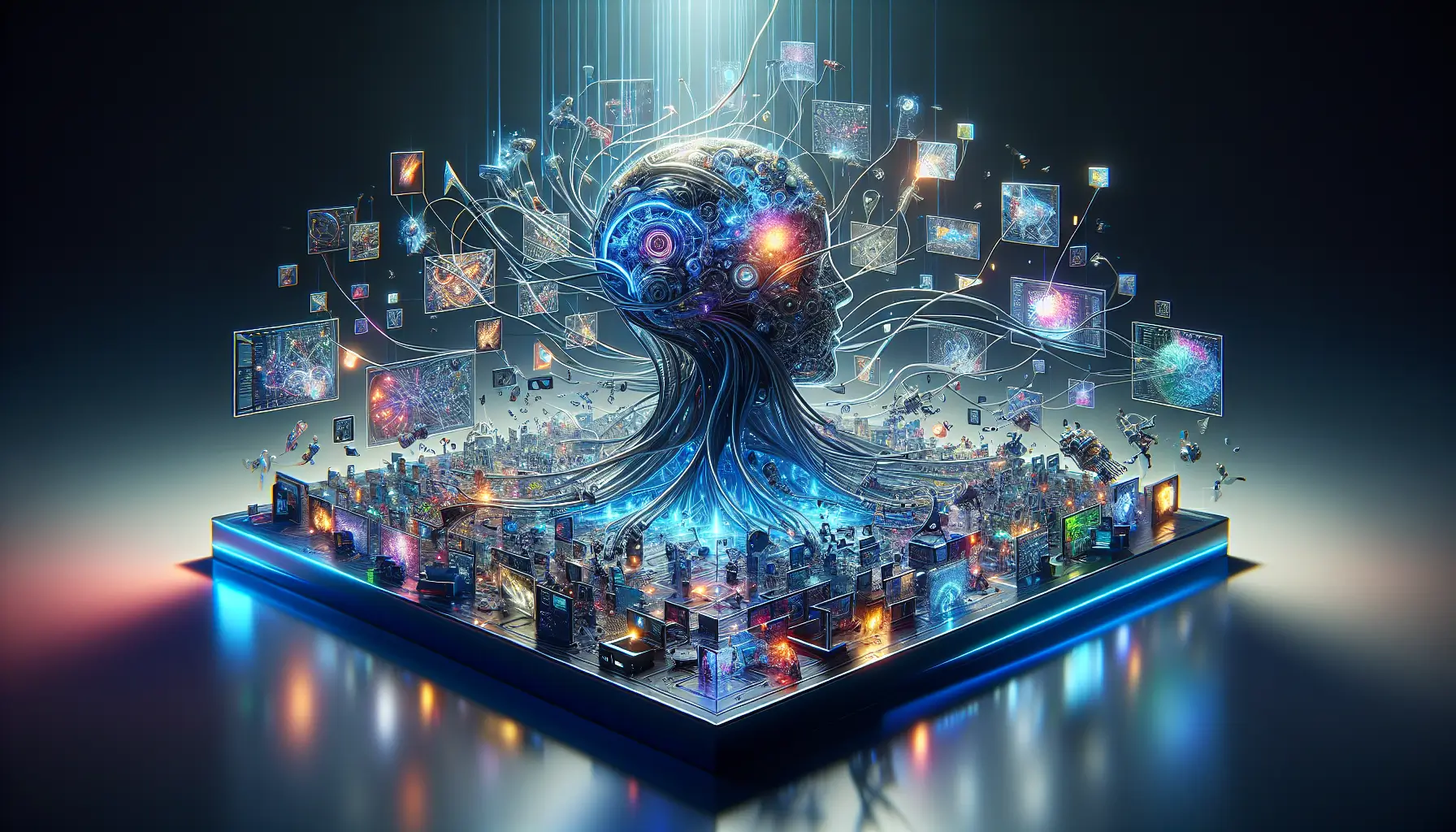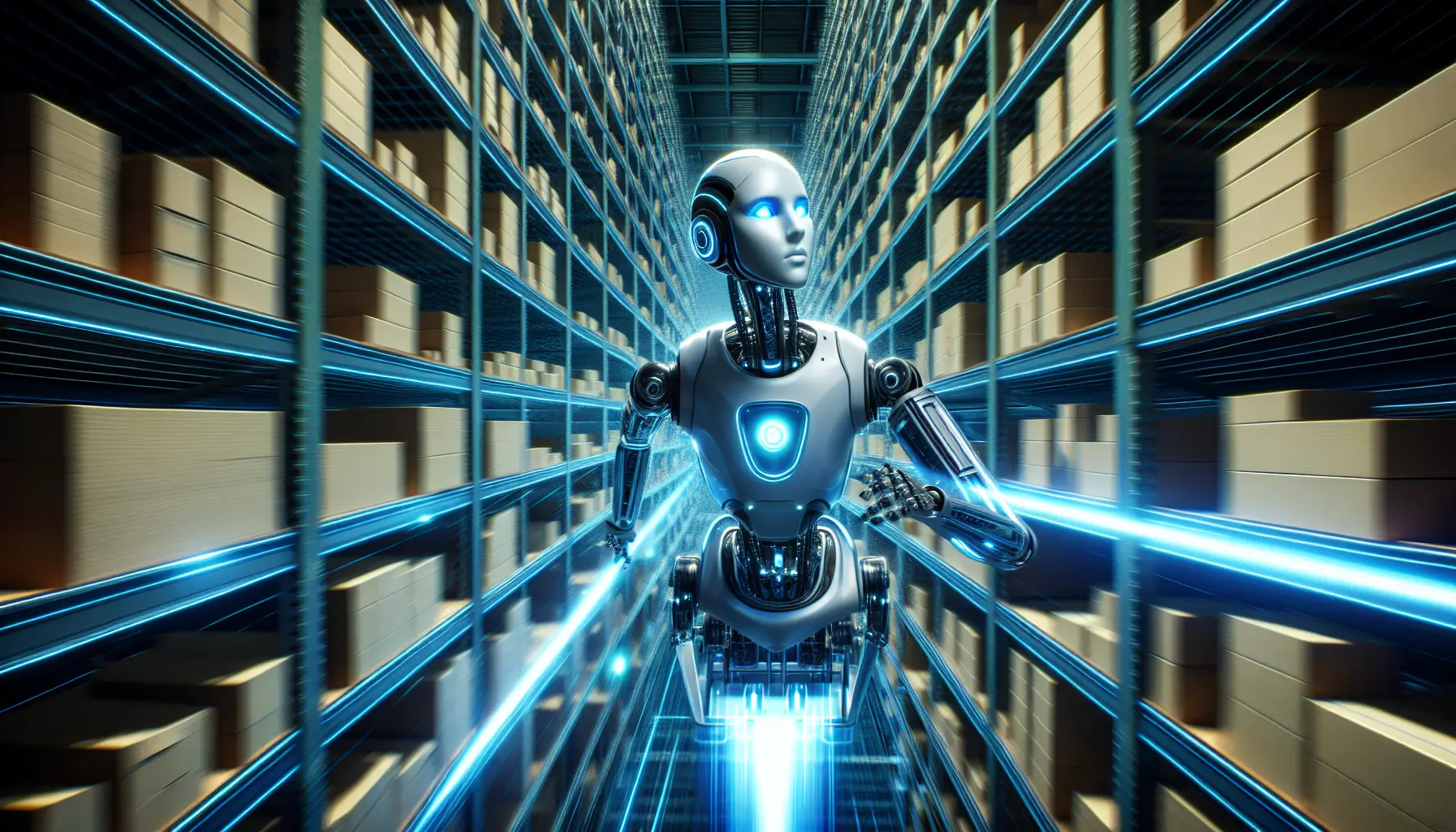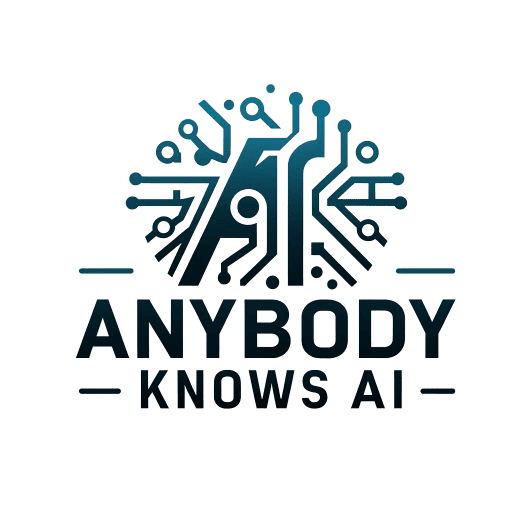Navigating the AI revolution requires knowing the top 10 AI technologies to watch in 2024. As AI’s role in digital transformation expands, it’s vital to understand the trends shaping our technological future. This article offers a no-nonsense look at the advancements set to redefine industries and showcases the innovations that matter. Get ready to explore the AI technologies that will influence tomorrow’s decisions today.
Key Takeaways
- Multimodal AI systems integrating text, speech, and vision are transforming user interaction across sectors, notably in medical diagnostics, personalized education, and immersive entertainment.
- Generative AI is reshaping various business sectors through enhanced content creation tools, requiring vigilance regarding ethical AI use to avoid misinformation risks and emphasizing the need for sustainable AI development.
- AI is revolutionizing supply chain management with machine learning, improving demand forecasting, AI-enhanced real-time logistics decisions, and automation in warehouse operations.
Emerging Multimodal AI Systems

Dawn is breaking on an era of multimodal AI systems, where AI technologies encompassing multiple input types revolutionize how we interact with the digital world. From the apps on our smartphones to the smart devices in our homes, AI systems are becoming increasingly intuitive, transforming mundane tasks into seamless interactions.
Through an amalgamation of text, speech, and vision, these systems have begun to redefine productivity and user experiences across sectors.
Imagine a world where the ability to design or code is no longer restricted to those with formal training. With multimodal AI, such a vision is becoming a reality. By allowing varied forms of user input – from vocal commands to visual content – these systems open new avenues for individuals and businesses alike. The real-world applications of this new technology are already making their presence felt, notably in:
- the medical field, where improved diagnostic accuracy is being achieved through AI’s ability to analyze medical images
- the education sector, where AI is being used to personalize learning experiences
- the entertainment industry, where AI is being used to create immersive virtual reality experiences
Multimodal AI is revolutionizing how we interact with technology and paving the way for a more inclusive and accessible future.
The rise of large language models and multimodal models is not just a trend; it’s a paradigm shift. The power of AI models lies in their ability to learn and adapt, and with multimodal AI, this learning process is becoming more holistic.
By integrating text, speech, and vision, these models can offer more well-rounded and intuitive applications, heralding a new era in AI development.
The Rise of Intuitive Virtual Assistants
The world of virtual assistants is transforming, with intuitive virtual assistants leading the charge. These intelligent virtual assistants (IVAs) are reaching new heights in understanding and interacting with users thanks to natural language processing and machine learning advancements. From handling inquiries to navigating complicated processes, IVAs are becoming valuable in business process management, enhancing customer service, and making business operations more efficient.
With the advent of retrieval-augmented generation, IVAs can check answers against external sources before responding, resulting in better-informed and more efficient interactions in enterprise applications. These AI-laden virtual assistants are not just a tech trend but the future of business operations.
Breakthroughs in Computer Vision
When it comes to AI technologies, computer vision stands out as a field that is witnessing remarkable breakthroughs. From understanding and describing visual content to tracking product movement in warehouses, computer vision is revolutionizing real-world applications and driving significant progress. The advent of smart glasses capable of interpreting and describing visual content is a testament to the power of AI in shaping our future.
Furthermore, the potential of technology doesn’t stop with smart glasses. It also plays a pivotal role in optimizing warehouse operations. By tracking product movement, computer vision technology allows for improved detection of bottlenecks and more efficient management of inventory levels.
The breakthroughs in computer vision promise a future where AI’s watchful eyes help us navigate our world more efficiently.
Enhanced Interaction with Everyday Devices
As we move into the digital age, our everyday devices are becoming smarter and more interactive, thanks to the integration of multimodal AI and interactive virtual assistants (IVAs). Contemporary generative AI models are multimodal, meaning they can create and interpret various types of content, facilitating more intuitive interactions with everyday devices.
The integration of IVAs with IoT devices is becoming more prevalent in smart homes and workplaces, allowing for sophisticated control and system management. This represents a significant leap forward in how we interact with our devices, making our everyday lives easier and more efficient.
Generative AI Revolution

As we navigate the AI landscape, one can’t help but notice the revolution brought about by generative AI. Over the past year, open-source projects in this field have seen significant contributor growth, bringing the power of sophisticated AI technologies to smaller entities. With the integration of generative AI into the fabric of existing applications, businesses are discovering new ways to leverage AI for various purposes.
However, the journey is not without its challenges. Businesses often underestimate the complexities associated with generative AI, such as ensuring data quality, training models, and AI system maintenance. Moreover, the hype surrounding generative AI has sparked discussions about realistic AI capabilities and managing disillusionment. But, as we continue to explore the potential of AI, advancing beyond the current hype involves setting realistic expectations and developing a mature understanding of AI’s limitations and potential.
At the same time, as we celebrate the advancements, we must also acknowledge the concerns regarding the heavy energy and resource requirements of generative AI, which are challenging its sustainability and efficiency.
Nevertheless, innovations such as retrieval-augmented generation are enhancing the relevance and accuracy of AI-generated content, paving the way for the future of AI.
Evolution of Content Creation Tools
The evolution of content creation tools powered by generative AI is remarkable. These generative AI tools are increasingly being utilized across various business sectors to accelerate processes in areas such as:
- Marketing
- Sales
- Product development
- Customer care
With the ability to produce a high content volume faster, businesses can potentially reduce their reliance on human content creators.
The rise of generative AI has also led to an increased demand for cloud infrastructure and powerful GPUs, a testament to the computing power required by generative AI. Edge computing, which allows for distributing computing resources closer to the user, is also critical in improving responsiveness and tailoring personalized experiences through AI-generated content.
Ethical Considerations in AI-Generated Media
As we continue to explore the potential of AI, it’s equally important to address the ethical considerations that come with it. In AI-generated media, concerns about misinformation and disinformation have escalated, with deepfakes and counterfeit content identified as top threats for 2024. The ethical risks in AI-generated press include:
- Misinformation
- Manipulation
- Identity theft
- They are facilitating cyber attacks such as ransomware and phishing.
Despite efforts to mitigate these risks, challenges remain. Some of the challenges include:
- Watermarking techniques intended for identifying AI-generated content can be easily bypassed
- Detection software sometimes produces false positives
- Mitigating bias is a critical ethical concern in machine learning, exemplified by Amazon’s scrapped hiring algorithm that discriminated against women.
These considerations emphasize the importance of ethical guidelines in developing and using AI technologies.
Generative AI in Complex Document Analysis
Generative AI is also making strides in the realm of complex document analysis. Platforms like Meta AI can increasingly provide detailed responses and accurate summaries suitable for complex documents utilized on mobile platforms. Furthermore, with retrieval-augmented generation (RAG), AI can check its proposed answers against external sources to ensure accuracy before responding, leading to more reliable interactions.
In business, generative AI enhances operations by enabling advancements in process mining, helping identify ways to streamline processes, create value, and cut costs.
AI-Enhanced Supply Chain Management
Regarding supply chain management, AI is proving to be a game-changer. AI transforms supply chains’ operations by enhancing visibility, optimizing operations, and improving customer service. Machine learning and AI have significantly improved demand forecasting by processing and analyzing vast amounts of data for accurate market predictions.
By accommodating complex variables like seasonality, promotions, and consumer behavior, AI and machine learning can make supply chain management more efficient and precise than traditional forecasting methods.
Integrating AI and machine learning into supply chain management can reduce supply chain network errors by 30% to 50%.
Furthermore, AI technology enhances business process management by utilizing data from multiple sources and automating repetitive tasks.
Predictive Analytics for Demand Forecasting
In supply chain management, predictive analytics is a powerful tool for demand forecasting. Companies like Amazon and Walmart use AI, notably machine learning, to analyze large volumes of historical sales data, enabling them to better manage inventories by forecasting product demand with higher accuracy.
Furthermore, AI-driven demand forecasting aids warehouse managers by predicting future demands, allowing for more efficient space utilization and inventory placement. With the help of AI, retailers can recognize emerging trends and forecast demand for new products, enabling more responsive supply chain practices.
Real-Time Decision Making in Logistics
Real-time decision-making is another area where AI is making a significant impact, particularly in logistics. AI-driven routing optimization reduces transportation costs and improves delivery timelines, assisting businesses with inefficient resource allocation.
By enabling real-time decision-making, AI is helping businesses to streamline their logistics operations and deliver better customer service.
Automation in Warehouse Operations

When it comes to warehouse operations, automation is the name of the game, and AI is leading the charge. AI-powered robots are being implemented in warehouse operations to perform tasks such as picking, packing, and shipping, aiming to boost efficiency and cut operational costs.
Furthermore, AI agents facilitate warehouse automation by interpreting natural language instructions to carry out commands for other AI bots, streamlining task execution.
With computer vision technology, businesses can monitor product movement and fine-tune inventory management to align with supply chain patterns.
AI Regulation and Compliance Landscape
As AI continues to evolve and become more integrated into our daily lives, the need for regulation and compliance has become more apparent. The European Union, for example, has passed the world’s first comprehensive AI regulatory framework, the EU’s AI Act, which will be implemented in phases through 2027. This legislation positions the EU as a global leader in the regulation of AI, setting a precedent for other countries to follow.
In the United States, states such as California, Colorado, and Virginia are creating their independent AI regulatory frameworks, recognizing the significance of AI in societal sectors by categorizing certain AI systems as high-risk and establishing measures like penalties for non-compliance, advisory councils, and ethics divisions.
These developments underscore the need for businesses to plan for regulation and institute controls as they implement AI systems, as failure to consider compliance from the outset may lead to scrambling to catch up when formal requirements become enforceable.
However, the evolving landscape of AI regulation and compliance may temporarily impede AI adoption as businesses navigate these uncertainties. As the AI landscape evolves, companies must remain vigilant and adaptable to navigate the changing regulatory landscape
.
Navigating the EU’s AI Act
The EU’s AI Act is a significant legislation businesses must understand and navigate. The act enforces prohibitions on AI practices such as:
- Subliminal manipulation
- Indiscriminate image scraping
- Biometric categorization systems with discrimination potential
- Social scoring
- AI used for socio-economic manipulation
In addition, tech companies must adhere to the AI Act’s obligations for transparency, including:
- Making clear when content is AI-generated
- Maintaining comprehensive technical documentation
- Conducting systemic adversarial testing for general-purpose AI systems.
Preparing for Comprehensive AI Law
The need for comprehensive AI law becomes increasingly important as AI integrates into our daily lives. One particular concern is the rise of Shadow AI, or the use of AI within an organization without explicit approval or oversight from the IT department. Shadow AI can lead to significant legal, regulatory, economic, or reputational consequences for businesses without proper supervision.
Organizations can set clear, acceptable AI use policies to manage Shadow AI, provide approved AI platforms, and encourage collaboration between IT and business leaders.
The Surge of Open Source AI Development
The rise of open-source AI development represents a significant shift in the AI landscape. In 2023, the AI industry experienced significant broadening, with powerful open-source AI tools emerging, giving smaller entities access to sophisticated technologies. With the surge of open-source AI, there is a noticeable trend toward maximizing the performance of compact AI models, which is important for broad deployment.
Simultaneously, a rising interest in AI technologies, such as prompt engineering within communities like Docker, indicates open source’s broader role in shaping software development and AI advancement. As the field of AI continues to evolve and grow, the role of open source in this development cannot be understated.
Open Models and Community Contributions
Open models and community contributions are also vital in the surge of open-source AI development. Community-driven generative AI projects are attracting considerable engagement, including from first-time contributors, illustrating a rise in collaborative innovation.
Furthermore, roles focused on machine learning engineering and data science within the Docker ecosystem have grown significantly, underscoring the need for expertise to drive AI advancements.
Balancing Innovation with Security in Open AI
As we continue to explore the potential of open-source AI, it’s equally important to balance innovation with security. Many popular open-source projects have adopted protected branches, demonstrating a commitment to maintaining security while fostering innovation. After security incidents like Log4Shell, technological companies have emphasized the importance of secure tooling and training to bolster security in open-source software and the supply chain.
However, despite the growing trend towards a more secure open-source community, there remains a need to enhance the integration of supply chain security technologies within software development processes. Furthermore, local AI training and model generation processes can help protect proprietary data from being exploited or inadvertently shared with external parties.
AI in Edge Computing

The integration of AI in edge computing is transforming how we process data. The growth of edge computing with AI is expected to reach a market size of USD 111.3 billion by 2028, indicating significant development and integration of AI at the network edge.
By bringing data analysis and AI-driven inference processes closer to the point of need, edge AI enables faster response times and reduces latency by processing data on local devices or nearby computers.
By allowing devices to process data in milliseconds, edge AI enables them to make faster local decisions without needing cloud servers or external centers. To enable these advanced edge AI capabilities, developers are utilizing edge development platforms to manage the complexity of deploying code across distributed points of presence, catering to engagement edge applications.
Enhancements in On-Premise Servers
Localized AI models and diverse processor capabilities are leading the way when enhancing on-premise servers. Industries such as legal, healthcare, and finance now utilize small, localized AI models that operate efficiently on modest hardware, avoiding the need for substantial infrastructure investments.
On-premise servers have diverse processors, including low-power microcontrollers and powerful GPUs, to cater to the varying AI workload requirements.
Paradigm Shift in Data Processing
The advent of AI in edge computing has brought about a paradigm shift in data processing. Edge AI fosters a transformative change in data processing, enabling real-time insights and actions across various industries. Real-time analysis and immediate data processing provided by edge AI are crucial for sectors like automotive, security, and healthcare, where decisions must be made swiftly.
To enable these advanced edge AI capabilities, local servers, and devices must have sufficient computing power, which may necessitate specific architectures catered to AI applications. This paradigm shift in data processing represents a significant step forward in the evolution of AI and its integration into our daily lives.
AI Tools in Software Engineering

AI is making waves in the field of software engineering, leading to methodologies that are more intelligent, efficient, and capable of adaptation. Tools such as ChatGPT, GitHub Copilot, and Bard are becoming integral to the coding practices of developers, enhancing rather than replacing human engineers.
By automating mundane tasks and enhancing the more creative and complex aspects of the development process, AI tools play a crucial role in shaping the future of software engineering.
The Emergence of Prompt Engineering
One of the most exciting developments in AI and software engineering is the emergence of prompt engineering. This burgeoning skill set combines software engineering precision with an understanding of human language to articulate queries that direct AI toward intended outcomes.
Today, prompt engineering is one of the most sought-after skills in the tech field, highlighting its growing importance and the necessity for individuals interacting with AI to master guiding and directing these models.
Smart Compose and Debugging Aids
Another exciting development in AI tools for software engineering is the advent of smart composing and debugging aids. Over half of surveyed developers use artificial intelligence to facilitate essential development tasks like code generation and debugging. By supporting developers in these areas, AI tools allow them to focus on more complex and innovative aspects of software creation.
Incorporating AI-powered tools is acknowledged as a significant enhancement within developers’ toolkits. By streamlining software development processes, these tools are making developers’ jobs easier and more efficient, allowing them to focus on more complex tasks and challenges.
Fine-Tuning AI for Customized Solutions
Fine-tuning AI for customized solutions enables organizations to cater to specific niche markets and meet unique user demands. Organizations differentiate themselves in a competitive marketplace by creating tailored local AI models using developments in open-source AI tools.
Powerful custom AI models are developed using proprietary data, allowing for finely tuned solutions tailored to organizational needs. As organizations continue to explore the potential of AI, the ability to fine-tune existing AI models for specific applications and demands is becoming increasingly important.
Specialization in Healthcare and Finance
AI is also significantly impacting specialized fields such as healthcare and finance. Generative AI can improve healthcare efficiency by addressing an expected shortfall of health workers, estimated to reach 10 million by 2030.
In addition to healthcare, industries such as legal and finance can strategically benefit from utilizing small, specialized local AI models.
Importance of Carefully Vetting Training Data
As we continue to explore the potential of AI, it’s important to remember that high-quality training data is vital for AI models to make accurate predictions and decisions. Insufficiently vetted training data can lead to errors in AI predictions, which may be costly or dangerous, depending on the application.
Using biased or irrelevant data in AI training can reinforce existing biases or result in misinformed AI decisions, negatively impacting fairness and effectiveness. To mitigate risks and maximize AI performance, it is essential to employ rigorous data curation and vetting practices that consider data relevance and potential biases.
AI’s Role in Digital Transformation
The role of AI in accelerating digital transformation cannot be overstated. Many industries, particularly those involving knowledge work such as:
- banking
- pharmaceuticals
- education
- technology
Companies are experiencing significant digital transformation driven by AI and the work of data scientists.
From improving customer satisfaction and employee engagement to enhancing market competitiveness, AI plays a crucial role in driving digital transformation in businesses across the globe.
Accelerating Business Processes with AI
AI is integrated into front-office processes to improve sales, customer satisfaction, and employee engagement. It optimizes customer interactions in contact centers by lowering wait times, personalizing recommendations, and providing real-time sales assistance.
AI applications in business process management (BPM) utilize:
- Machine learning models for identifying optimization opportunities
- Digital twins for scenario analysis
- Deep learning for process data analysis
- AI for quick data extraction from documents
These technologies contribute to refined decision-making.
AI’s Impact on Market Competitiveness
Organizations with advanced AI capabilities enhance their market competitiveness by using AI to:
- Develop innovative products and services
- Create digital twins to model physical environments and complex systems efficiently
- Facilitate scenario analysis and informed decision-making
- Gain a competitive edge
By developing proprietary AI-based features, businesses can differentiate themselves in a competitive market, enhancing their market competitiveness.
AI and Ethical Considerations
As we delve into the world of AI, it’s important to consider the ethical implications of this technology. Generative AI has sparked ethical discussions concerning its responsible use, particularly for potential job displacement and privacy issues in personalized advertising.
The EU’s AI Act is part of a regulatory effort to ensure responsible AI development, banning certain AI uses and requiring obligations from developers of high-risk AI systems and corporate transparency.
Establishing Ethical Guidelines for AI Use
The rapid advancement of AI technologies has led to concerns over their potential impact on privacy, security, and social dynamics. Without proper ethical guidelines, there is a risk that AI technologies could be misused or cause unintentional harm. Industry groups and think tanks are working to establish standards that guide AI’s ethical development and use.
These industry standards aim to ensure AI respects human rights, follows fair and transparent practices, and includes accountability measures.
Addressing Bias in Machine Learning
Addressing bias in machine learning is a critical aspect of ethical AI. Diverse teams in AI development can bring various perspectives that result in more inclusive algorithms less prone to bias. Carefully vetting the data used for training machine learning models is crucial in mitigating biases that may be present in the data.
Training data often come from historical records, which can reflect past biases and societal inequalities, making identifying and correcting these biases essential.
Here’s a detailed table featuring the top 10 AI technologies to watch in 2024, highlighting key aspects and advancements in each area:
| AI Technology | Description | Impact Area |
|---|---|---|
| Generative AI | Advanced AI can generate text, images, and videos, simulating human creativity. | Content creation, media, entertainment |
| AI for Autonomous Vehicles | Technologies like computer vision and sensor fusion empower self-driving cars and drones for navigation. | Transportation, logistics |
| AI in Cybersecurity | Utilizes anomaly detection and predictive capabilities to enhance security measures and mitigate threats. | Security, network protection |
| Explainable AI (XAI) | It makes AI decisions transparent and understandable, essential for trust in critical applications. | Healthcare, finance |
| AI in Finance | Revolutionizes fraud detection, algorithmic trading, and personalized financial services. | Banking, investment |
| AI in Healthcare | Supports diagnostics, drug discovery, and patient management, integrating with telemedicine and wearables. | Medical diagnostics, treatment |
| Edge AI | Allows real-time AI processing on edge devices, reducing cloud dependency. | IoT, smart devices, real-time applications |
| AI in Climate Modeling | Enhances the analysis of climate data and the forecasting of environmental changes. | Environmental science, policy |
| Large Language Models | Powers applications with deep understanding and generation of human language. | Tech, customer service, content generation |
| AI for Protein Folding | Facilitates the understanding of protein structures, crucial for medical research and drug development. | Biotechnology, pharmaceuticals |
These technologies are at the forefront of their respective fields and hold transformative potential for various industries. As these technologies evolve, they are expected to drive significant advancements and efficiencies across multiple sectors.
Overview
As we conclude our exploration of the top 10 AI technologies to watch in 2024, it’s clear that AI is not just a trend but a transformative force shaping our future. From multimodal AI systems enhancing our interactions with virtual assistants and everyday devices to generative AI revolutionizing content creation and complex document analysis, AI is changing how we live and work.
As we navigate the evolving regulatory and ethical landscape, it’s evident that responsible AI development and use is key. As we look to the future, we can anticipate a world enhanced by AI, driven by innovation, efficiency, and ethical considerations.
Frequently Asked Questions
What are multimodal AI systems?
Multimodal AI systems encompass multiple input types, such as text, speech, and vision, revolutionizing how we interact with the digital world.
How is generative AI influencing content creation?
Generative AI influences content creation by accelerating marketing, sales, product development, and customer care processes, reducing the need for human content creators.
What are the ethical considerations in AI-generated media?
The ethical considerations in AI-generated media encompass concerns about misinformation, manipulation, identity theft, and cyber attacks. These raise important issues that require careful attention and respect.
How is AI enhancing supply chain management?
AI enhances supply chain management by improving visibility, optimizing operations, enhancing customer service, and forecasting demand. This can lead to more efficient and effective supply chain processes.
What is the EU’s AI Act?
The EU’s AI Act is the world’s first comprehensive AI regulatory framework, enforcing prohibitions on certain AI practices and requiring obligations from developers of high-risk AI systems and corporate transparency.







